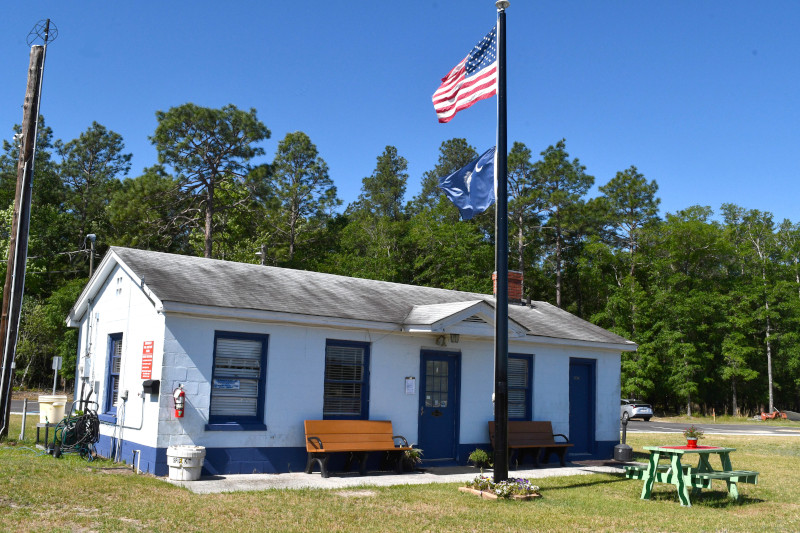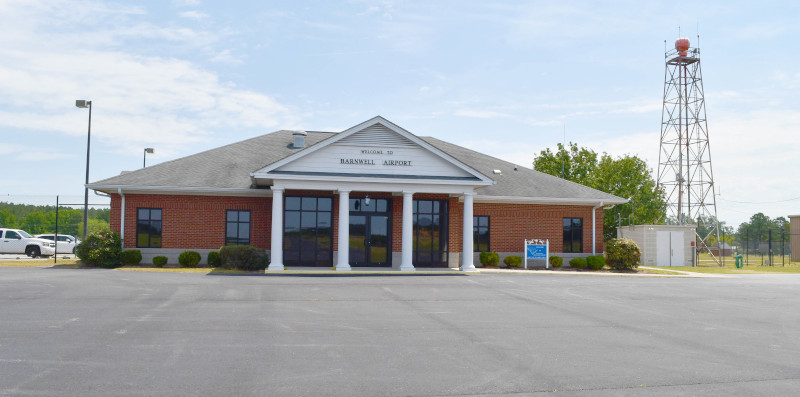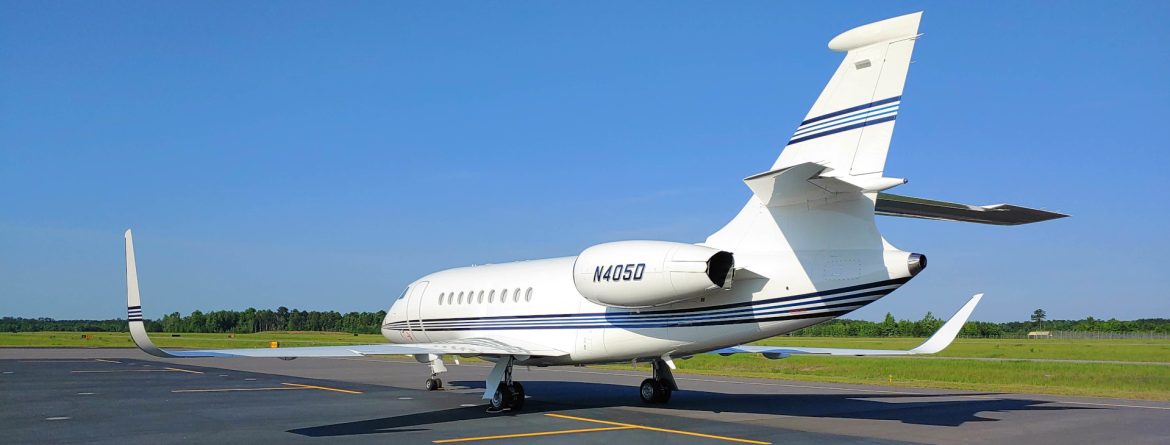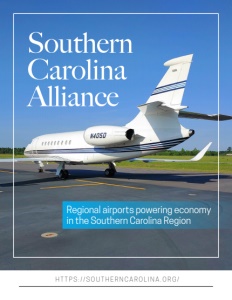Southern Carolina Alliance
Regional airports powering economy in the Southern Carolina Region
The hum of an engine overhead is more than just a motor powering a small airplane over treetops; it’s an economic engine that is powering the Southern Carolina region.
South Carolina has 57 airports, six of which are commercial service airports while the rest are considered “general aviation” airports. Those 57 airports generate $16.3 billion annually in economic activity in the state of South Carolina, according to a 2018 study commissioned by the South Carolina Aeronautics Commission.

Hampton Terminal
In the Southern Carolina Alliance region (which includes the counties of Allendale, Barnwell, Bamberg, Beaufort, Colleton, Hampton and Jasper), over $220 million in economic activity is generated annually as a result of the one commercial and seven general aviation airports located here. This economic activity doesn’t even include impact generated by the military base in Beaufort.
In 2018, these eight airports accounted for 1,739 jobs with a payroll of over $60.6 million. The vast majority of the jobs were created by Hilton Head Island Airport, however 453 jobs were generated at the general aviation airports, according to the SCAC study.
While those economic impact numbers are significant, area airport managers say the numbers have risen dramatically since the report was generated. Covid was actually a boon, they say, because county airports offered less restrictions and greater ability for people to travel in small groups.
The airports are able to record “airport operations” including take offs and landings as well as estimate passengers and they consider “visitors” as those who are coming from more than 50 miles away. Additionally, there are pilots who base their aircraft at the airports, renting space and using the runways frequently.
The seven smaller airports attract over 33,878 visitors to the Southern Carolina region, and Hilton Head’s airport adds another 30,000 visitors annually, according to the 2018 study. People come here for business, pleasure or a combination of both. Some flights are just passing through, using the airports as fueling stations and taking advantage of their facilities for bathrooms, food and information.
Most of the airports offer “quiet” areas where pilots can take a nap, have a shower, get a snack or use computers available on site and these areas are open to pilots 24 hours a day, seven days a week.
All of the airports in the SCA region sell 100LL (low lead) fuel for the smaller prop planes, several also offer Jet A fuel for small jet-engine planes. Fuel sales are a major source of income for these airports and they compete rigorously to offer the lowest pricing. Pilots can look online for pricing while making their flight plans, check in-flight or be happily surprised upon landing and inquiring.
Income for the airports is also derived from renting space for short-term parking, or in buildings called T-hangars or box hangars where planes can be stored for longer periods of time. Many don’t charge “tie-down” fees for short visits, enticing pilots to use their facilities. Other revenue is generated from repair facilities, flight schools or other aviation-related businesses that rent space at the airports.
The smaller airports offer less hassle and more anonymity for visitors, some of whom are on economic development missions for their companies. Having an airport nearby often is one important item on a checklist for companies seeking locations to build or expand. Their first impression of a community is the airport, which is why local governments invest in nice, clean facilities that are comfortable with artistic touches. Many of the terminals either have just undergone extensive upgrades or there are plans to do so in the relatively near future.
Marco Cavazzoni, representing District 6 on the S.C. The Aeronautics Commission, said at a recent aviation event in the region, “Magical stories often happen around aviation.”

Barnwell Airport
Now retired, Cavazzoni noted his first experience was in 2009 when he flew into the Bamberg County Airport “in the dark of night on Halloween incognito” on a mission for his former employer, Boeing, to consider placing a plant in North Charleston. The result was a historic decision for South Carolina.
European-born Cavazzoni and his family liked to drive through rural areas and were enchanted by the region. By meeting people and getting to know the area, Marco said he came to realize how important the rural communities are to the state and nation. He has since located his personal aircraft and invested in aviation-related businesses in Colleton County.
Funding from the South Carolina Aeronautics Commission (SCAC) and the Federal Aviation Administration (FAA) has been a critical key to helping local governments maintain and upgrade their airport’s runways and facilities.
The majority of the airports in the SCA region were created in the 1930’s and 40’s and are steeped in history. That history is also a draw to visitors to the airports and nearby parks.
Each airport has unique characteristics including its designation code, runway length, services, amenities and history.
Ridgeland-Claude Dean Airport (3J1) in Jasper County is an airport that is on the verge of greatness. As a result of the $23 million already spent and the additional $6 million scheduled to be spent, the airport will become a full-service professional airport. Jasper County is basically building a new airport on the campus of the old airport, according to Development Services Division Director and Acting Airport Manager Danny Lucas.
Phases 1 – 4 included a 215-acre land purchase, construction of a new runway and parallel taxiway, construction of a new 84,000 square-foot jet ramp, construction of a 32-stall parking lot and laying the groundwork literally and figuratively for new facilities.
In 2020, the new 4,200-foot runway and parallel taxiway were opened. The former 2,672-foot runway was turned into a taxiway. Already there are plans underway to extend the new runway another 1,200 feet, although Lucas admits that the extension is a number of years away.
A modular temporary terminal/fixed base operation (FBO) has opened. Furniture and fixtures have also been installed. “We are in the latter stages of the design of the permanent terminal/FBO,” said Lucas.
“We are in Phase 5 now,” said Lucas. That includes installation of an Automated Weather Observation Station, creation of a permanent terminal / fixed base operation, an instrument landing system, building 12-unit T-hangars, and another ramp.
One recent project that is having a huge impact on the airport is the installation of two 12,000-gallon fuel tanks and trucks. “The airport is now selling aviation gasoline and jet fuel,” stated Lucas.
He said he hopes Ridgeland-Claude Dean will be a full-service airport by the end of 2026 although construction and delivery timelines have been impacted by Covid, companies experiencing labor challenges, and supply-chain issues.
The SCAC study reported 1,540 visitors annually to the Ridgeland airport.
Ridgeland – Claude Dean Airport is approximately 40 minutes from Bluffton, 50 minutes to Hilton Head Island and 60 minutes to Savannah.
The airport is “a gateway to the community,” said Lucas. “Jasper County Council wants make sure the new airport makes a positive impression upon business and recreational visitors. In addition, we are eight minutes away from the PGA-class golf course, Congaree.”
The CJ Cup held at Congaree in October resulted in 8 golfers arriving in private jets and 4 private aircraft carrying spectators. Lucas reported that 18 jets and 3 turbo props visited the airport during the tournament. Additionally, 4,073 gallons of fuel was sold during the tournament.
Otherwise, some of the “unknown” visitors, Lucas is sure, are people coming in for economic development reasons and seeking privacy in their flights.
Congaree Golf Club and Turkey Hill Plantation provide shuttle services to their facilities. Ridgeland’s airport has a contract with Enterprise car rental and also owns a courtesy van for 2-hour usage by pilots.
“The airport is also home to 70 based aircraft with a waiting list of pilots wanting to call Ridgeland their home airport,” said Lucas. “We are making room for business and recreational aviation. It is an exciting time for aviation in our region.”
Lucas is convinced that those changes will have a huge economic impact on the future of the community.
The SCAC 2018 report reported $8.3 million in economic impact at the Ridgeland airport so the changes will only make that number grow.
Sourcing for this submission is listed below*******
Links:
Allendale County Airport – www.allendalecounty.com/government/allendale_airport.php
Bamberg County Airport – www.bambergair.com
Barnwell County Airport – www.barnwellregionalairport.com
Beaufort Executive Airport – www.beaufortcountyairport.com
Hampton County Airport – www.hamptoncountysc.org
Hilton Head Airport – www.hiltonheadairport.com
Lowcountry Regional Airport – www.lowcountryairport.com
Ridgeland – Claude Dean Airport – www.jaspercountysc.gov/ridgeland-claude-dean-airport-3j1-/home
South Carolina Aeronautics Commission – www.scaeronautics.sc.gov
SCAC study – 2018 South Carolina Executive Summary-Final.pdf (sc.gov)
SouthernCarolina Alliance – www.southerncarolina.org
AT A GLANCE
Southern Carolina Alliance
WHAT: A non profit focused on attracting companies to South Carolina
WHERE: Serving the 6 counties of Southern Carolina
WEBSITE: southerncarolina.org


